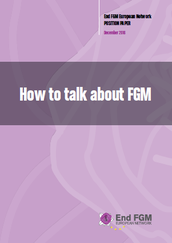'How to talk about FGM' Position Paper (2016)
The End FGM European Network has recently published a position paper about ‘How to talk about FGM’.
The subject of FGM arouses debates, controversy, emotions and reactions. Because it encompasses a variety of areas, from human rights, women’s rights, body and gender-based violence to health, tradition and culture, it is a particularly sensitive matter to tackle, especially for people and organisations involved in ending the practice, such as FGM survivors, anti-FGM campaigners, non-governmental organisations (NGOs), national authorities and international bodies.
Language is an essential and powerful tool in ending this harmful practice. Vocabulary may seem symbolic in the context of a human rights violation yet terminology, narratives and discourse are crucial tools to convey messages that contribute to raising awareness, to women’s, girls’ and communities’ empowerment and to their ability to speak out against the harmful practice of FGM, all elements essential towards the elimination of the practice. Words and their connotations are powerful and have an impact on how a subject is perceived and tackled. An inaccurate or demeaning use of vocabulary, instead of an empowering and careful use of terminology, can cause misunderstandings and misconceptions, and might even be detrimental both to the global movement against FGM and for women and girls in need of protection and care.
Through this position paper, the End FGM European Network sets out its approach to language in the global movement to End FGM. It is intended for any person seeking information on FGM and the vocabulary used in the field, and is of particular interest to the media and other professionals reporting on the subject or in contact with FGM survivors and FGM-affected communities. To ensure an accurate understanding of the practice, the paper first presents the official definition of female genital mutilation and its related denominations in different contexts. We then present narratives and discourse surrounding the practice and provide recommendations to avoid stigmatisation and promote empowerment.

